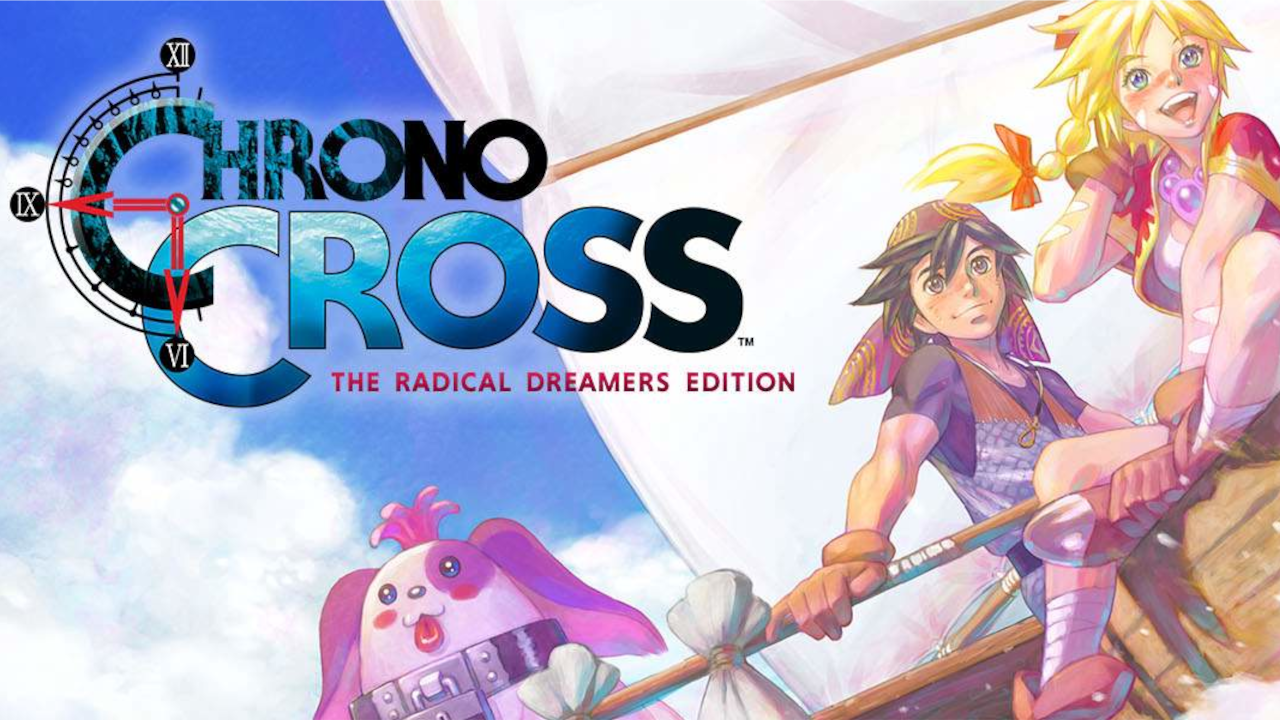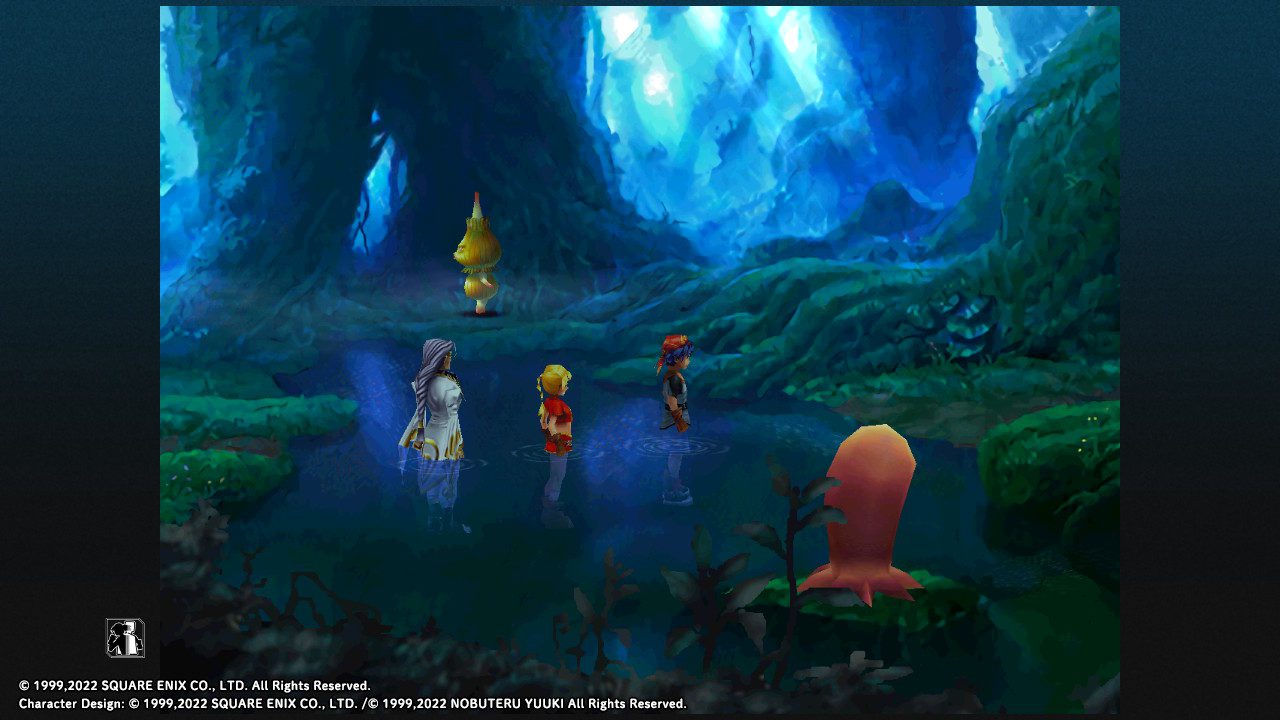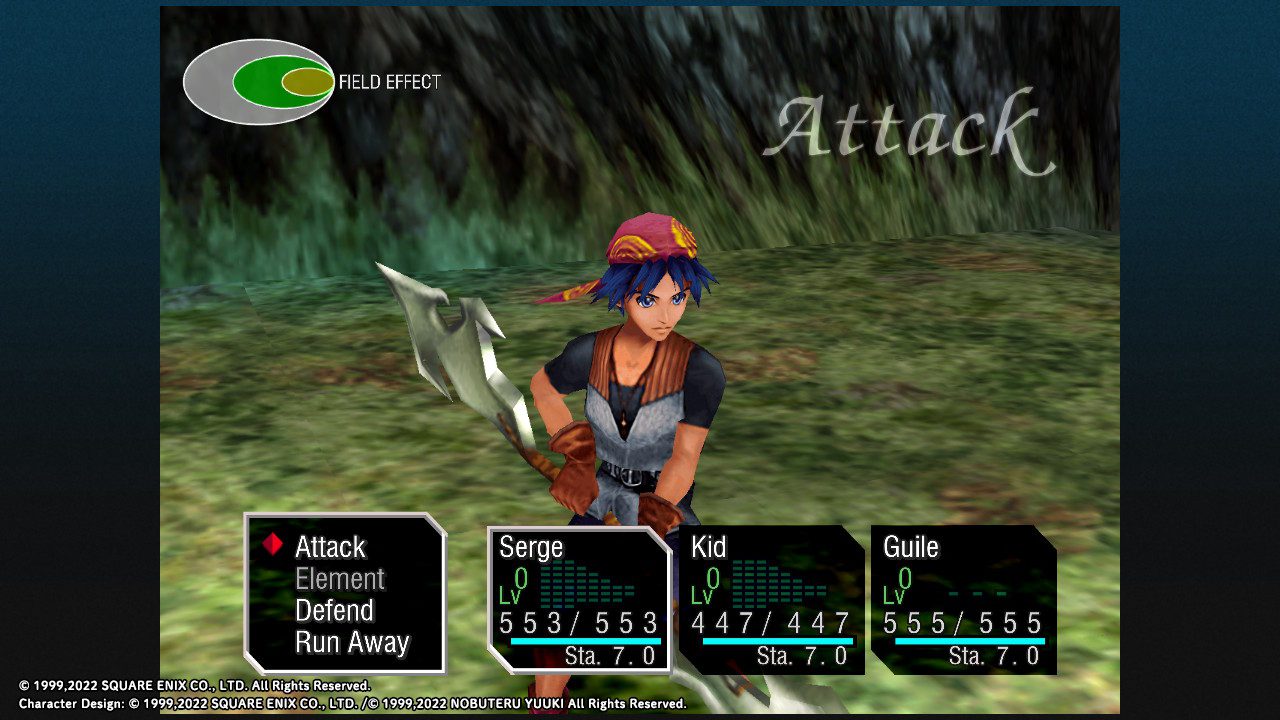
Earlier this year, Chrono Cross, sequel to the famed Chrono Trigger, received the modern remaster treatment with the release of Chrono Cross: The Radical Dreamers Edition. The standard improvements in remasters that classic JRPG fans have come to expect in this age of re-releases are all present: improved models, better quality audio, game speed adjustments, optional combat perks, etc. More importantly though, the uniqueness and charm of the original has been preserved and made easily accessible on current generation hardware.
Chrono Cross shares a game world and certain themes with its predecessor, but little else. Indeed, its design is a departure from its genre peers as well, and has yet to be copied or adopted in a spiritual successor. Such juxtaposition of tradition and experimentation is perhaps fitting for a game centered on parallel worlds, and makes for an adventure that, for JRPG fans, is something that should definitely be experienced.

Off to a pleasant start.
The story starts in a familiar fashion with you taking the role of Serge, a young man living in a quiet seaside village in an island chain named El Nido. Your first quest is simply to obtain a handful of scales for your friend, but this mundane mission is quickly interrupted as Serge is ripped into a world just like his own, but with one important difference. In this other world, Serge is dead. In that sense, the amnesiac-hero trope is flipped around. You have not forgotten the past – you are the forgotten past.
You soon find yourself the subject of a manhunt, and are aided by a mysterious girl who has a beef with your pursuers. Initially your goal is to find a way back home, but each intermediate success poses new questions and raises the stakes as the plot broadens to an epic scope. References to its predecessor are many, so players who have not completed Chrono Trigger may miss out on the ways in which Chrono Cross builds on the lore of the original. The game also boasts a large cast of characters, though the focus is clearly on piecing together the plot’s puzzle. Characterizations are largely limited to text affectations, and even the principal players are not incredibly deep. This certainly did not ruin the experience for me, it’s just something you’ll notice in contrast to other JRPGs if you’re a fan of the genre. Uncovering what is really going on in El Nido is satisfying in its own right, in part due to the gorgeous artwork and stunning soundtrack.

Ambulant flora are not to be trusted.
Chrono Cross’s tropical setting is presented with vivid backgrounds covering a wide variety of biomes. You’ll traverse lush beaches, shadowy forests, desert islands, volcanic peaks, port cities, and more – all in a hand painted style that I suspect was a contrast to some of the more muted and technological settings of its 90’s JRPG contemporaries. The character designs are similarly colorful, though their in-game models show their age in this remaster.
The soundtrack, however, is timeless. Yasunori Mitsuda returns as the composer, and nearly every composition is beautiful, memorable, and is worth listening to long after the game is over. The instrumentation is as unique as the art direction – there’s little brass or bombast – it’s mostly woodwinds, piano, and strings that serve as a perfect companion to the island environs and are evocative of its mysteries. Even if you have no interest in playing this game, do yourself a favor: open up Spotify and find the Chrono Cross soundtrack. Whether it’s Scars of Time, Shore of Dreams, Sailing, or Radical Dreamers, you will not be disappointed.

Counter-clockwise from Top Left: Field Effect Queue, Attack options, Character Status Panes, and finally some big ol’ formatted text to ensure you know what you’re about to do.
Memorable art and music may not be anything new in a classic JRPG, but the combat mechanics in Chrono Cross are truly unique, and require a bit of explanation. Character customization is handled by means of the “Element Grid”, a collection of columns with discrete numbers of slots in which to place your magical attacks, dubbed “Elements”. Each individual Element has two main properties: an innate color and a grid column constraint. The colors each represent an elemental motif and are broken into three opposing pairs. (For example, red fire spells are strong against innately blue enemies, and vice versa.) You then have the freedom to choose whether to diversify, or focus on particular colors to optimize for a given encounter or dungeon. Grid placement, on the other hand, allows you to trade between ease-of-casting and output strength. Elements placed rightward in the grid do more damage, but require more of a particular resource to cast.
That resource is your Magic Level, and it is generated by landing physical attacks. Light, medium, and heavy attacks award you one, two, or three points respectively. The heavier the attack, the harder to hit, however each successive attack in a turn increases your chances of landing any attack. As long as you have Stamina, you have the option of continuing your attack chain, casting a spell, or defending. Physical attacks cost up to 3 Stamina points depending on attack strength, while Elements generally put the character in a negative-Stamina state. Fortunately, characters not taking actions recharge Stamina while the active character attacks.
One additional wrinkle of combat is the field color, which is a first-in-first-out queue of the colors of the last three Elements cast. The more an Element appears in the queue, the stronger it becomes, which sometimes makes for interesting tactical decisions. For example, there may be times when certain healing spells could pose a long-term risk, if they contribute to filling the queue with the opponent’s innate color, which improves the strength of their attacks.
In practice, the battles are not as complicated as the explanation above may suggest. Your Element grid is essentially a hand of cards, your physical attacks determine which cards you may play, and your Stamina determines when you may take an action.
At first, I found this system a refreshing change of pace, but it wore on me to the point where battles became a bit of a chore. I truly appreciate the fact that the system does not require or encourage grinding, but there’s also no fundamental change to the battles over the course of the game. Characters do develop, but the gains are in stat increases and added Element Grid slots that are entirely out of your control. You’ll get access to more powerful spells, but you’re essentially just doing the same thing with flashier animations and bigger numbers. Crafting unique character builds and finding fun combinations is not a part of Chrono Cross’s battle system. The system has potential, though, and if a sequel or spiritual successor ever were to take inspiration from it, I would hope its designers would lean harder into the card battle mechanisms and make the choice of element colors more meaningful. Giving each color a specific playstyle focus, in addition to their aesthetic differences, would’ve filled that hunger for additional character customization, and made battles more satisfying.
Obviously, other players may differ on their enjoyment of the battle system, but I do think the main quest has enough momentum, particularly for those who’ve played the original, to keep them invested through to the end. What’s more – the artwork and music are of the highest quality and serve to make Chrono Cross a memorable and worthy experience.
Scoring: 83%
Gameplay: 3/5
The battle mechanics are unique and interesting, but have a what-you-see-is-what-you-get quality that can wear over time.
Story: 4.5/5
The story is compelling, generally well-paced, and does a good job of building up from what are initially pretty intimate stakes. It’d be nice to have a little more development of at least the main characters, but that never really detracts from the overall experience.
Sound: 5/5
I’d argue this is one of the best JRPG soundtracks, if not one of the best video game soundtracks in general. (Only the battle themes fall short – everything else is fantastic.)
Replayability: 4/5
Chrono Cross encourages subsequent playthroughs so you can explore the ramifications of different choices, and provides different endings.
Morality/Parental Warnings
The violence is fairly mild and fantastical, but for a pivotal scene that marks the close of the first act. Even then, it’s not excessive, but it’s more than I’d want my relatively young children to see.
There are also a few character models that are lightly clad and/or provocatively designed, and one cutscene reminiscent of the opening of The Terminator. Some dialogue is suggestive (and not entirely subtly so), but Chrono Cross’s T rating is probably pretty fair there, too.
A discussion of any spiritual value of Chrono Cross’s themes is all but impossible without spoilers, so while I will endeavor to be somewhat vague, consider yourself warned.
Spiritual Value (spoilers)
There doesn’t appear to be any notion of a Creator in the world of Chrono Cross, so when it is revealed that humanity’s dominant place in the world is simply a side-effect of the arrival of the villain in the first game, Chrono Cross’s conclusion is that humans are unnatural aggressors against the environment. It’s not communicated with much subtlety, so I’m sure it’s intended to prompt introspection about our place in the world, and the effects our actions have. As Catholics, we would certainly agree that humans should be good stewards of the environment, but not to a self-destructive degree. Chrono Cross isn’t arguing for self-destruction, either, since you still ultimately fight to defend humanity. However, without any rooting in some sense of the transcendent, the game has difficulty articulating why humanity is worth defending.
Still, there’s a Tower of Babel quality to the tale, in that the central conflicts are the result of men assuming they have complete mastery over time and space. The unintended consequences of their hubristic actions are on full display, and you go to great lengths to clean up the mess.
